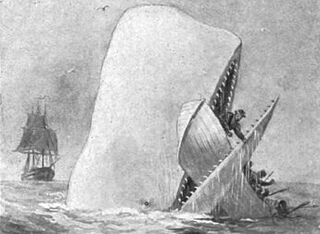Depression
Herman Melville: The Troubled Years After Moby Dick
Part II of a series examining Melville's life and struggle with mental illness.
Posted October 24, 2021 Reviewed by Tyler Woods
Key points
- The writing of Moby Dick marked the emergence of unexplained medical complaints, and mood swings from boundless energy to deep despair.
- Financial pressures and the deaths of his sons led to social withdrawal; at home he was compared to the tyrannical sea captains in his novels.
- In his late 60s he began work on Billy Budd, which some have interpreted as showing a reconciliation with the vagaries and injustices of life.
In the first article of this series, I described how Herman Melville was born into a mercantile family which fell on hard times, his adventures as a seaman and harpooner in the Pacific as a young man, and his budding career as a writer of adventuresome tales. In 1850, the influence of Nathanial Hawthorne led him to transform his new project on the obsessive pursuit of a great white whale from a dashing sea story into something much deeper and allegorical. As we will see, in the process and then moving into his later years, he developed a variety of medical complaints, and his mood swings, with periods of boundless energy and grandiosity followed by the depths of despair, became more evident.

Moby Dick, which came out first as The Whale in 1851 in London and a month later with its final title in the U.S., was not a success initially. Americans were turning westward by this time, and novels of the seafaring life had less appeal. Melville became increasingly reclusive and distressed. He began to experience a variety of difficulties including eye strain, rheumatism, back pain, and sciatica. As the years went on he was to complain frequently of visual difficulties and sensitivity to bright light. Some of his acquaintances thought these various symptoms might be caused by a kind of mental exhaustion known then as ‘neurasthenia’. It is also possible that they resulted from unrelated illnesses, perhaps exacerbated by long hours working by candlelight at a desk; one modern interpretation is that they all resulted from an illness known as ankylosing spondylitis1.
In an attempt to recapture his standing, Melville published Pierre in 1852, drawing heavily from his youthful family life, and again faced critical reviews. Though only in his early thirties, he believed that he was a failure, with nowhere else to go, a feeling which was exacerbated by a fire at his publishers’ offices in New York, burning much of his work. During this period he wrote several short stories, notably ‘Bartleby the Scrivener’, describing an office worker whose growing depression has been seen by some critics as mirroring Melville’s own mood.
Seeking Solace in Travel
During a visit with Hawthorne, who was then living in London, it became apparent that their friendship had cooled. Melville then traveled on to the Holy Land in the hopes of finding inspiration. While in Jerusalem he had one of his many episodes of eye difficulties, which he thought might be due to the bright sunlight.
Melville returned to America dispirited and in financial distress, and for several years became an itinerant lecturer on topics related to travel. He had a tradition of turning to the sea when he felt depressed, described both in his writings about himself and fictionally in the opening of Moby Dick, and so he set sail on his brother Tom’s clipper ship for a voyage into the Pacific, returning early from San Francisco.
The Troubled Customs Inspector
Finally, in 1866 he got a position as a customs inspector on the New York docks, which gave him some financial security for the next two decades, though it seemingly did little to improve the depressed mood which continued to haunt him. Earlier in his life, he had described mood fluctuations which in Moby Dick he had likened to the flight of a Catskill eagle, sometimes soaring so high as to be ‘invisible in sunny spaces’ and at other times dropping down into the ‘blackest gorges’. Though, as he noted, even when flying low, the eagle was in the mountains and still above birds from the lowlands, his remaining years were mostly spent in a life of isolation and often despair.
Melville turned to poetry, and in 1866 published at his own expense ‘Battle-Pieces and Aspects of the War’. Though later considered a classic of American verse, at the time it sold poorly—less than 500 copies in the first years—returning only half of the expense of publication, and contributing further to his financial straits. By 1867 his moodiness and ill-temper left his home life a shambles. The degree to which drinking contributed is not clear. Some have considered him a heavy drinker while others have suggested that this has been exaggerated1. His mood swings and the mistreatment of his family led some to compare him to the despotic sea captains in his novels2. At one point his wife talked of faking a kidnapping as a way of fleeing the situation. He got along poorly with his son Malcolm, who in 1867 shot himself, and was found by Melville after he failed to appear from his bedroom. In the years that followed, Melville continued writing poetry and in 1876 came out with Clarel, a remarkably long religious work (longer than the Iliad or Paradise Lost), based on his previous trip to the Holy Land. It too, was not received well at the time.
Final Years
Leaving his customs job in 1885, he continued his reclusive life. He was devastated even more by the 1886 death in San Francisco of his younger son Stanwix, a seaman.
In the late 1880s, he began work on the prose novel Billy Budd, about a youthful and naïve sailor who is wrongly accused of mutiny and strikes his tormentor, accidentally killing him. Billy’s acceptance of his sentence to be hanged, and the inner peacefulness with which he approached the gallows has been taken by some as Melville’s reconciliation, or perhaps resignation to life with all its vagaries3. The novel was not yet in final form when he was felled by a heart attack in September, 1891.
While decades before he had been considered one of the leading American writers, his death was largely unnoticed, and what little material appeared in the press did not go well. The New York Times obituary referred to ‘Mobie Dick’, and a later article called him ‘the late Hiram Melville’4. The Billy Budd manuscript languished until 1919 when it was found in a breadbox by his granddaughter, who sent it along to an English professor at Columbia; it was ultimately published in 1924, to much acclaim. In the next installment of this article, we will look at how Melville’s personal and family history have suggested to some that he suffered from bipolar illness, and if so, how it might have interacted with his life and writing.
Portions of this article were adapted from Fragile Brilliance: The Troubled Lives of Herman Melville, Edgar Allan Poe, Emily Dickinson and Other Great Authors.
References
1. Ross, J.J.: The many ailments of Herman Melville (1819-1891). J. Med. Biog. 16: 21-29, 2008.
2. Robertson-Lorant, L. Melville: a Biography. Clarkson Potter, New York, 1996, p. 504.
3. Maxwell, D.E.S.: Herman Melville, American Author. In Encyclopedia Britannica, 1998. https://www.britannica.com/biography/Herman-Melville
4. Parker, H.: Herman Melville: a Biography, Volume II, 1851-1891. Johns Hopkins University Press, Baltimore, 2002, p. 921.




